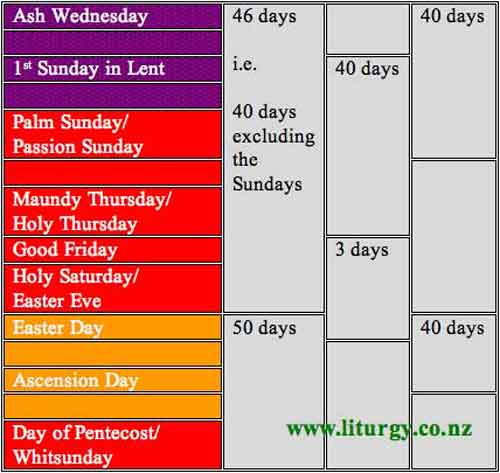OK – so there’s a few obsessions that Bosco has: collects, unfussy worship, allowing symbols to speak for themselves,… and… that Easter is fifty days.
Great Christian festivals begin in the evening after sunset, are celebrated through the day and on into the next evening. But Bosco thinks Easter begins in the evening with the Easter Vigil and is celebrated for fifty days as one long festival.
He’s tried taking the Easter-is-only-one-day pills. He’s tried taking the Easter-is-only-forty-days pills. But they just aren’t curing him. The obsession that Easter is a seventh of the year, the Great Sunday of the year, the 50 days of the Early Church, and Nicaea, and… (OK, OK, settle down)… just won’t go away.
The drive to screw and lock the Easter Candle stick into the sanctuary floors of church buildings, only posting them the key on the Day of Pentecost; the Tourette-like compulsion to keep shouting Alleluia! at almost every turn – these appear to be incurable.
The strangeness of the disease can, however, be mitigated by others sharing in these obsessions. It’s a small price to pay to keep Bosco happily churning out more blog posts and liturgical resources here.
Click on Easter is 50 days, and press “going”. Then share the link with all your friends (virtual and non-virtual ones), tweet it, put it on your facebook profile, add it to your blog, print it on your service sheets. Here’s a link that’s easy to remember http://tinyurl.com/50daysofeaster. Do this for 50 days 🙂
You can already see Bosco thinking… wouldn’t it be cool if this year Easter went viral…
Many people like, from time to time, to add a badge to their website or blog. You will usually find samples on the Liturgy home page.
The HTML for adding the above badge to your blog or website is:
Please let it be known in the comments if the coding is, or is not correct.





Absolutely. This is incredibly important. I’ve used a hashtag #Easteris50days at least once in a Tweet, but if we all can get it to trend, then we’ve got a chance at vitality. Let’s do this.
I also share a sick passion for collects.
And if you’re going to bother to process in, please recess out.
There. Done.
Thanks for your enthusiasm, Karin. Christ is risen!
I’m with you all the way, Bosco, if you’ll join my crusade to tell the world that Pentecost has 7 days 🙂
Have you come across Fr. Zuhlsdorf’s account of how Paul VI wept when he was presented with a green chasuble on Monday in Whitsun Week?
http://wdtprs.com/blog/2010/05/a-pentecost-monday-lesson-and-paul-vi-wept/
Sorry, Jesse… I think the story is a nice one, but sounds like a creation to press a certain liturgical direction… 🙂
I’m afraid I’m with the Nicene Fathers and others: Pentecost is 50 days. Pentecost IS the Easter Season. Trinity Sunday is not the first Sunday of Pentecost, it is the first Sunday after Pentecost.
Christ is Risen!
Exactly. That’s why Pent. only has 7 days, not an octave!
I’m tempted to be intrigued, Jesse, because you can’t say “exactly” and then write a contradiction…
I am of course being perverse. But as a medievalist, I get to have my cake and eat it! 🙂
Accretion, duplication, elaboration, circles within circles — these are not always bad, even if they have not ranked high amid the pastoral concerns of the liturgical renewal movement. (Catherine Pickstock nails it, I think, with her concept of “liturgical stammering”.)
I see no reason to limit myself to one level of insight (however profound) into the organization of the liturgical year. Easter was, of course, originally a unitary feast: Gethsemane, Calvary, Sepulchre, all rolled into one (we have the references to people groaning and beating their breasts at the reading of the Passion Narrative on Easter Day). And the light of this feast fires the whole year, as John Keble puts it in The Christian Year:
Enthroned in thy sovereign sphere,
Thou shedd’st thy light on all the year;
Sundays by thee more glorious break,
An Easter Day in every week:
And week days, following in their train,
The fulness of thy blessing gain,
Till all, both resting and employ,
Be one Lord’s day of holy joy.
But the Church has allowed the meaning of this feast to refract, like light through a prism, so that the mystery of our redemption can be appreciated in all its subtly shaded hues.
So fifty days of Easter, absolutely. But also Pentecost observed with the dignity it is capable of bearing all on its own: the prototypical “novena” of expectation leading up to it, and a proper “leave-taking” after it.
And it concludes, not with an “octave” (hence the BCP preface is only used on the “six days following”), but with the late-but-wonderful feast of the Most Holy Trinity, which, especially in the BCP tradition of numbering the “Green” Sundays, gives to “ordinary time” a character of doxology for the mighty works of God in Christ, and in the Church through the Spirit.
YES! to all that, Jesse. As I wrote on another blog post as a comment recently – I’ve developed the ability to, having painted myself into a corner, leap over vast areas of wet paint. Very Anglican. Both/and. And in the Southern Hemisphere, of course, and appropriately, the week following the Day of Pentecost is the Week of Prayer for Christian unity (don’t think Christians are united in agreeing which week to pray for Christian unity!) Christ is risen!
Right on, Bosco! I’ve never thought of Eastertide as one long Sunday and one seventh of the year. This thinking makes Easter Week/Paschal Octave slightly artificial, I suppose.
I felt very let down today when the dismissal at the mid-week HC I attended was given minus the concluding “Alleluias”. I shall add them next time, regardless of how the celebrant bids us go.
The “A Prayerbook for Australia” gives some fine Eastertide post-communion anthems but I’m still waiting to experience them. The Liturgy book has only been in use since 1995 so I suppose the clergy are still in the experimental phase…
Thanks, Steve. That Easter is one great Sunday I certainly cannot claim as an original insight 🙂 St Athanasius, to name but one, wrote thus; and it is in the Vatican’s rules for the fifty days.
The NZ Prayer Book gets bored with Easter after a couple of days (there is Monday in Easter Week and Tuesday in Easter Week, but no Wednesday or days after that) and Sundays become “after Easter” – whereas, following what I am advocating, they are Sundays of Easter.
Christ is risen!